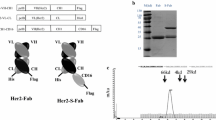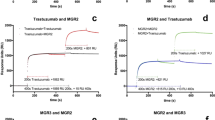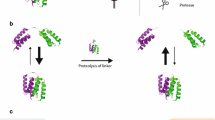Abstract
In the past decade, various single-domain antibodies from llamas, also known as VHH or nanobody, have been discovered with applications in tumor imaging and cancer therapy. However, the potential application of anti-HER2 VHHs as a diagnostic tool suitable for ELISA, flow cytometry, cell imaging, bispecific antibody engineering, and immunohistochemistry has not been fully elucidated. To investigate this potential, HER2 antigen was expressed in HEK293 F cells, purified, and used to immunize llama. Using phage display, anti-HER2 VHHs with high affinity and specificity were isolated, sequenced, and constructed with a Histag and c-Myc tag. The constructed anti-HER2 VHHs were then expressed in E. coli, purified, and evaluated for their use in ELISA, flow cytometry, cell imaging, and immunohistochemistry. The affinities of the anti-HER2 VHHs toward the HER2 antigen were determined using biolayer interferometry. Furthermore, the binding sites of the anti-HER2 VHHs were evaluated by epitope map** and in silico modeling and docking. Here, we report the sequence of an anti-HER2 VHH with high affinity (sub-nanomolar), specificity, and selectivity. This VHH binds to the same epitope as trastuzumab and can be utilized to generate bispecific antibodies or used as a diagnostic tool to differentiate HER2+ from HER2- antigens on plates, cells, and tissues. This discovery has broad applications in biochemical, biological, and medical sciences.









Similar content being viewed by others
Data availability
All data supporting the findings of this study are available within the paper and its Supplementary Information.
References
Friedlaender A, Subbiah V, Russo A, Banna GL, Malapelle U, Rolfo C, et al. EGFR and HER2 exon 20 insertions in solid tumours: from biology to treatment. Nat Rev Clin Oncol. 2022;19(1):51–69. https://doi.org/10.1038/s41571-021-00558-1.
Albanell J, Baselga J. Trastuzumab, a humanized anti-HER2 monoclonal antibody, for the treatment of breast cancer. Drugs Today (Barc). 1999;35(12):931–46.
Pondé NF, Lambertini M, de Azambuja E. Twenty years of anti-HER2 therapy-associated cardiotoxicity. ESMO Open. 2016;1(4):e000073.
Suter T, Cook-Bruns N, Barton C. Cardiotoxicity associated with trastuzumab (Herceptin) therapy in the treatment of metastatic breast cancer. Breast. 2004;13(3):173–83.
Sendur MA, Aksoy S, Altundag K. Cardiotoxicity of novel HER2-targeted therapies. Curr Med Res Opin. 2013;29(8):1015–24.
Dempsey N, Rosenthal A, Dabas N, Kropotova Y, Lippman M, Bishopric NH. Trastuzumab-induced cardiotoxicity: a review of clinical risk factors, pharmacologic prevention, and cardiotoxicity of other HER2-directed therapies. Breast Cancer Res Treat. 2021;188(1):21–36. https://doi.org/10.1007/s10549-021-06280-x.
Keefe DL. Trastuzumab-associated cardiotoxicity. Cancer. 2002;95(7):1592–600.
Telli ML, Hunt SA, Carlson RW, Guardino AE. Trastuzumab-related cardiotoxicity: calling into question the concept of reversibility. J Clin Oncol. 2007;25(23):3525–33.
Ewer SM, Ewer MS. Cardiotoxicity profile of trastuzumab. Drug Saf. 2008;31(6):459–67.
Pan X, Zhou P, Fan T, Wu Y, Zhang J, Shi X, et al. Immunoglobulin fragment F (ab’) 2 against RBD potently neutralizes SARS-CoV-2 in vitro. Antivir Res. 2020;182:104868.
Rathore Y, Shukla J, Lakhanpal T, Laroiya I, Deep A, Kumar R, et al. 28P Development 68Ga trastuzumab Fab and bioevaluation by PET imaging in HER2/neu-expressing breast cancer patients. Ann Oncol. 2022;33:S1441.
Zhang H, Ye X, Wen J, Cai Z, Li Y, Zhang M, et al. Anti-HER2 scFv-CCL19-IL7 recombinant protein inhibited gastric tumor growth in vivo. Sci Rep. 2022;12(1):10461.
Pruszynski M, D’Huyvetter M, Bruchertseifer F, Morgenstern A, Lahoutte T. Evaluation of an anti-HER2 nanobody labeled with 225Ac for targeted α-particle therapy of cancer. Mol Pharm. 2018;15(4):1457–66.
Orlova A, Magnusson M, Eriksson TL, Nilsson M, Larsson B, Höidén-Guthenberg I, et al. Tumor imaging using a picomolar affinity HER2 binding affibody molecule. Cancer Res. 2006;66(8):4339–48.
Arezumand R, Alibakhshi A, Ranjbari J, Ramazani A, Muyldermans S. Nanobodies as novel agents for targeting angiogenesis in solid cancers. Front Immunol. 2017;8:1746.
Hamers-Casterman C, Atarhouch T, Muyldermans S, Robinson G, Hamers C, Songa EB, et al. Naturally occurring antibodies devoid of light chains. Nature. 1993;363(6428):446–8. https://doi.org/10.1038/363446a0.
Steeland S, Vandenbroucke RE, Libert C. Nanobodies as therapeutics: big opportunities for small antibodies. Drug Discov Today. 2016;21(7):1076–113.
Ackaert C, Smiejkowska N, Xavier C, Sterckx YG, Denies S, Stijlemans B, et al. Immunogenicity risk profile of nanobodies. Front Immunol. 2021;12:578.
Allegra A, Innao V, Gerace D, Vaddinelli D, Allegra AG, Musolino C. Nanobodies and cancer: current status and new perspectives. Cancer Investig. 2018;36(4):221–37.
Majerle A, Hadži S, Aupič J, Satler T, Lapenta F, Strmšek Ž, et al. A nanobody toolbox targeting dimeric coiled-coil modules for functionalization of designed protein origami structures. Proc Natl Acad Sci U S A. 2021;118(17):e2021899118.
Dmitriev OY, Lutsenko S, Muyldermans S. Nanobodies as probes for protein dynamics in vitro and in cells. J Biol Chem. 2016;291(8):3767–75.
Ingram JR, Schmidt FI, Ploegh HL. Exploiting nanobodies’ singular traits. Annu Rev Immunol. 2018;36:695–715.
Harmand TJ, Islam A, Pishesha N, Ploegh HL. Nanobodies as in vivo, non-invasive, imaging agents. RSC Chem Biol. 2021;2(3):685–701.
Keyaerts M, Xavier C, Heemskerk J, Devoogdt N, Everaert H, Ackaert C, et al. Phase I study of 68Ga-HER2-nanobody for PET/CT assessment of HER2 expression in breast carcinoma. J Nucl Med. 2016;57(1):27–33.
D’Huyvetter M, De Vos J, Caveliers V, Vaneycken I, Heemskerk J, Duhoux FP, et al. Phase I trial of 131I-GMIB-Anti-HER2-VHH1, a new promising candidate for HER2-targeted radionuclide therapy in breast cancer patients. J Nucl Med. 2021;62(8):1097–105.
Nikkhoi SK, Li G, Eleya S, Yang G, Vandavasi VG, Hatefi A. Bispecific killer cell engager with high affinity and specificity toward CD16a on NK cells for cancer immunotherapy. Front Immunol. 2022;13:1039969. https://doi.org/10.3389/fimmu.2022.1039969.
Romão E, Poignavent V, Vincke C, Ritzenthaler C, Muyldermans S, Monsion B. Construction of high-quality camel immune antibody libraries. In: Phage Display: Methods and Protocols; 2018. p. 169–87.
Vaneycken I, Devoogdt N, Van Gassen N, Vincke C, Xavier C, Wernery U, et al. Preclinical screening of anti-HER2 nanobodies for molecular imaging of breast cancer. FASEB J. 2011;25(7):2433–46. https://doi.org/10.1096/fj.10-180331.
Nomani A, Li G, Yousefi S, Wu S, Malekshah OM, Nikkhoi SK, et al. Gadolinium-labeled affibody-XTEN recombinant vector for detection of HER2+ lesions of ovarian cancer lung metastasis using quantitative MRI. J Control Release. 2021;337:132–43.
Malekshah OM, Sarkar S, Nomani A, Patel N, Javidian P, Goedken M, et al. Bioengineered adipose-derived stem cells for targeted enzyme-prodrug therapy of ovarian cancer intraperitoneal metastasis. J Control Release. 2019;311:273–87.
Brochet X, Lefranc M-P, Giudicelli V. IMGT/V-QUEST: the highly customized and integrated system for IG and TR standardized VJ and VDJ sequence analysis. Nucleic Acids Res. 2008;36(suppl_2):W503–W8.
Pettersen EF, Goddard TD, Huang CC, Meng EC, Couch GS, Croll TI, et al. UCSF ChimeraX: structure visualization for researchers, educators, and developers. Protein Sci. 2021;30(1):70–82.
Ko J, Park H, Heo L, Seok C. GalaxyWEB server for protein structure prediction and refinement. Nucleic Acids Res. 2012;40(W1):W294–W7.
Comeau SR, Gatchell DW, Vajda S, Camacho CJ. ClusPro: a fully automated algorithm for protein–protein docking. Nucleic Acids Res. 2004;32(suppl_2):W96–W9.
DeLano WL. Pymol: an open-source molecular graphics tool. CCP4 Newsl. Protein Crystallogr. 2002;40(1):82–92.
Contessa JN, Bhojani MS, Freeze HH, Rehemtulla A, Lawrence TS. Inhibition of N-linked glycosylation disrupts receptor tyrosine kinase signaling in tumor cells. Cancer Res. 2008;68(10):3803–9.
Jumper J, Evans R, Pritzel A, Green T, Figurnov M, Ronneberger O, et al. Highly accurate protein structure prediction with AlphaFold. Nature. 2021;596(7873):583–9.
Ubbiali D, Orlando M, Kovačič M, Iacobucci C, Semrau MS, Bajc G, et al. An anti-HER2 nanobody binds to its antigen HER2 via two independent paratopes. Int J Biol Macromol. 2021;182:502–11.
Kanthala S, Mill CP, Riese DJ II, Jaiswal M, Jois S. Expression and purification of HER2 extracellular domain proteins in Schneider2 insect cells. Protein Expr Purif. 2016;125:26–33.
Oh D-Y, Bang Y-J. HER2-targeted therapies—a role beyond breast cancer. Nat Rev Clin Oncol. 2020;17(1):33–48.
Nami B, Maadi H, Wang Z. Mechanisms underlying the action and synergism of trastuzumab and pertuzumab in targeting HER2-positive breast cancer. Cancers. 2018;10(10):342.
Li JY, Perry SR, Muniz-Medina V, Wang X, Wetzel LK, Rebelatto MC, et al. A biparatopic HER2-targeting antibody-drug conjugate induces tumor regression in primary models refractory to or ineligible for HER2-targeted therapy. Cancer Cell. 2016;29(1):117–29.
Xavier C, Blykers A, Vaneycken I, D’Huyvetter M, Heemskerk J, Lahoutte T, et al. 18F-nanobody for PET imaging of HER2 overexpressing tumors. Nucl Med Biol. 2016;43(4):247–52.
Acknowledgements
This work was supported by grants from the New Jersey Health Foundation (PC95-20), NIH/NHLBI (U01HL150852), and Rutgers HealthAdvance program. This work was also supported in part by the NIH/NCI flow cytometry (P30CA072720-5924) shared resources of the Rutgers-Cancer Institute of New Jersey (NCI-designated Comprehensive Cancer Center). The content is solely the responsibility of the authors and does not necessarily represent the official views of the National Institutes of Health.
Author information
Authors and Affiliations
Contributions
SKN contributed to methodology, validation, formal analysis, investigation, writing original draft, and visualization. HH, VGV, GY, PL, and MP were involved in methodology. HO contributed to manuscript writing and language editing. AH contributed to conceptualization, methodology, validation, formal analysis, resources, writing, review and editing, visualization, supervision, project administration, and funding acquisition. All authors contributed to the article and approved the submitted version.
Corresponding author
Ethics declarations
Conflict of interest
The authors declare no competing interests.
Additional information
Publisher’s note
Springer Nature remains neutral with regard to jurisdictional claims in published maps and institutional affiliations.
Supplementary information
ESM 1
(DOCX 14 kb)
Rights and permissions
Springer Nature or its licensor (e.g. a society or other partner) holds exclusive rights to this article under a publishing agreement with the author(s) or other rightsholder(s); author self-archiving of the accepted manuscript version of this article is solely governed by the terms of such publishing agreement and applicable law.
About this article
Cite this article
Nikkhoi, S.K., Heydarzadeh, H., Vandavasi, V.G. et al. A high affinity and specificity anti-HER2 single-domain antibody (VHH) that targets trastuzumab’s epitope with versatile biochemical, biological, and medical applications. Immunol Res 72, 103–118 (2024). https://doi.org/10.1007/s12026-023-09418-9
Received:
Accepted:
Published:
Issue Date:
DOI: https://doi.org/10.1007/s12026-023-09418-9




